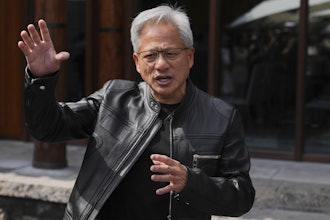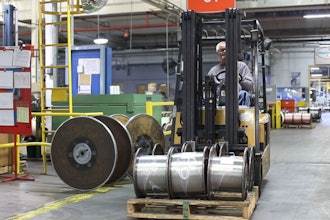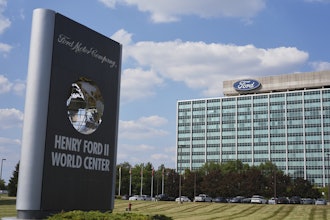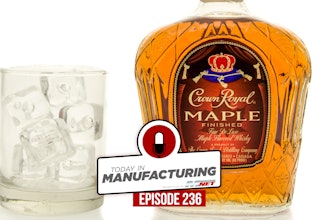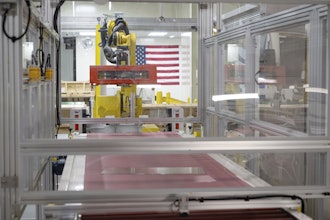We live in a world surrounded by food. No longer do we just eat food; we also stare at it, take pictures of it and post them to social media. Food reality shows like Top Chef, Cake Boss, and Chopped are commonplace, and chefs have become bona fide celebrities, known internationally for their signature recipes.
Many top chefs today are also known for their artistic food designs and arrangements. There are even entire museums completely dedicated to food, like the one in Hangzhou, China, where visitors can gaze at artistically-plated Chinese dishes. There’s also New York’s Museum of Food and Drink and Chicago’s Foodseum.
Some might argue our current fixation with looking at food is teetering on obsession, hence the now ubiquitous term used to describe this phenomenon – “food porn.”
A recent obsession for many gourmands is pastry masterpieces created by Blue Bottle Coffee’s pastry chef Caitlin Freeman, inspired by iconic works of art. Her signature “Mondrian cake” (inspired by Piet Mondrian’s painting “Composition (No. III) Blanc-Jaune/Composition (No. III) with Red, Yellow, and Blue”) particularly stands out. Freeman created her art-inspired desserts at the San Francisco Museum of Modern Art (SFMOMA), where Blue Bottle operated a café from 2009 until 2013. When SFMOMA reopened last month after a 3-year expansion project, Freeman was shocked to learn Blue Bottle had been replaced by another café (McCall Catering’s Café 5) that was apparently selling similar art-inspired cakes.
The question for chefs like Freeman is whether they can do anything to prevent another from copying their culinary creations for economic gain, especially in an industry where chefs sometimes borrow and build upon ideas from their contemporaries. When properly applied, intellectual property law is flexible enough to protect highly creative food designs from substantial copying, but with built-in limitations that safeguard against stifling collaboration in the food industry. Here’s how:
Let’s Chew On Copyrights
Copyright law protects an artist’s original, creative expression fixed in a tangible medium. It does not protect merely utilitarian articles, ideas, facts, or formulas. Since food is a useful article, copyright law will be applicable only if the food incorporates highly creative features that are separable (either physically or conceptually) from the food’s utilitarian features.
Conceptual separability is particularly relevant when it comes to culinary creations like, Freeman’s Mondrian cake. The cake’s artistic features appear separate from its utilitarian functions (i.e., the ability to eat the cake, its taste and nutritional value). The cake design also appears to be an original artistic expression, even though it is inspired by Piet Mondrian’s painting. Freeman’s creation is arguably transformative because it imbues the pre-existing artwork with a new expression and a different character. Also, while the cake is meant to be consumed (and thus may not be “fixed” permanently), fixation requires only that a work be perceived for more than a transitory duration. Thus, Freeman’s art-themed desserts would appear to be the quintessential example of the kind of food that should be entitled to copyright protection against others creating substantially similar designs.
Because copyright law does not protect mere ideas, facts, or formulas, a chef cannot secure rights for being the first to come up with the idea of creating a certain style of food (e.g., art-inspired pastries). Likewise, although a compilation of recipes and descriptions in a cookbook are often entitled to some level of copyright protection, merely listing ingredients in a recipe is not because recipes are considered facts and formulas. These limitations should allow chefs to continue to borrow recipes and ideas from others without violating copyright laws.
Under copyright law, it is generally permissible to borrow ideas and even look at a prior work for inspiration. The critical inquiry is whether you borrowed too much and impermissibly created a derivative work, or whether you transformed the original into a new creation that could itself be considered original and not a derivative. A chef who, without permission, creates a derivative food design that is substantially similar to another’s copyright-protected food design or other work could be at risk for copyright infringement claims. As for Freeman’s art-themed desserts, although inspired by pre-existing art, many appear to be highly transformative of the original art, and the Mondrian cake itself is based on prior art currently in the public domain.
Sinking Your Teeth into Patents
You can obtain a utility patent on a novel and non-obvious recipe or cooking technique. You can also obtain a design patent for a novel, non-obvious and ornamental food creation. However, overcoming the novel/non-obvious hurdle under patent law is difficult in the food industry, given the custom of borrowing from others (which is called prior art in the patent world). For example, Smuckers’ utility patent for its crimped and crustless peanut butter and jelly sandwiches (called Uncrustables®) was found to be invalid, partially due to obviousness. Let’s face it, there’s nothing new about PB&J, and Uncrustables’ crimped edges look just like ravioli.
Nonetheless, examples of food patents that have been issued include a utility patent covering a recipe for instant stuffing mix, a utility patent for a method of making microwavable sponge cake, a design patent for Cold Stone Creamery’s signature Strawberry Passion ice cream cake, and a design patent issued for Breyer’s Viennetta ice cream cake. In light of these examples, it is reasonable to conclude that uniquely styled foods such as Freeman’s Mondrian cake could also be protected under patent law, thus preventing others from offering substantially the same design.
You Can’t Have Your Trade Secrets and Eat It, Too
A chef that does not want to disclose his recipe as part of the patent application process can rely on trade secret law if the recipe is of limited availability, has economic value and is kept secret. Famous examples of recipes protected as trade secrets include KFC’s original fried chicken recipe and the formula for Coca-Cola. Beyond secret recipes, however, trade secret law seems to fall flat in protecting other aspects of the culinary arts, like food designs and arrangements, which are meant to be viewed and thus not kept secret.
The Cream of the Crop is Trademarks
In addition to trademarking the name of a food product, restaurant or chef, one can also trademark the design and appearance (known as “trade dress”) of a food configuration, so long as the design is non-functional and has achieved consumer recognition as a source identifier (called “secondary meaning”). There are several well-known food configurations that are registered trademarks, including Pepperidge Farm’s Goldfish Crackers and Milano Cookies, Hershey’s Chocolate Bar, Frito-Lay’s Sun Chips, and every child’s favorite whale-shaped ice cream cake, Carvel’s “Fudgie the Whale.”
Food trademark registrations are not limited to pre-packaged store-bought food designs produced by large companies. Smaller food shops, restaurants, and cafés have also obtained trademark protection for their food products. New York-based Magnolia Bakery obtained a trademark registration for its cupcakes bearing its signature swirl icing. Magnolia also has a trademark registration for its “icebox cake.” Minneapolis ice cream shop Izzy’s Ice Cream Cafe obtained a trademark registration for ice cream cones topped with a “baby scoop” of ice cream (called the “Izzy Scoop®”). A Utah-based restaurant called J Dawgs was even able to obtain a trademark registration for hotdogs with crisscross cuts.
Food configurations like Freeman’s Mondrian cake may also be entitled to trade dress protection. The Mondrian cake should be considered non-functional since the design is not dictated primarily by utilitarian concerns. The cake also appears to have achieved a high level of consumer recognition, based on its extensive media coverage (including an episode of the Food Network show “The Best Thing I Ever Ate”), sales of Freeman’s cookbook “Modern Art Desserts” depicting the Mondrian cake on its cover, Freeman’s Modern Art Desserts Blog (which also uses an image of the Mondrian cake as a logo), numerous Internet search result hits for the cake, and numerous Mondrian cake fans sharing photos on social media of the cake (or their attempts to make the cake). Whether consumers recognize the cake design as a source indicator has not been tested as far as we know.
Your Goose is Cooked!
Beyond lawsuits for breach of trade secrets and nondisclosure agreements, chefs and others in the food industry rarely invoke intellectual property law in response to copying. However, there are cases where copyright, patent, and trademark law have been invoked to combat alleged food plagiarism. Here are some recent lawsuits worth noting:
Magnolia Bakery sued a former employee who opened a competing café called Apple Café Bakery, mere blocks away from Magnolia’s Greenwich Village flagship location. Magnolia’s complaint alleged the former employee committed trademark infringement when he used Magnolia’s signature swirl icing on the tops of his cupcakes. Magnolia claimed that its swirl-topped cupcakes had become famous among consumers, in part due to its use for over 15 years and the notoriety it received from being featured on television shows like Sex and the City and films like The Devil Wears Prada. Apple Café ultimately closed its doors and the parties entered into a confidential settlement agreement according to the case docket. Magnolia Intellectual Property, LLC v. Trawally et al. (S.D.N.Y. Sep. 20, 2012).
Leslie Friend, owner of a design patent for a peace sign-shaped pretzel, commenced a lawsuit for patent infringement against Keystone Pretzels and Laurel Hill Foods for making and selling peace sign-shaped pretzel snacks. Friend demanded the companies pay her a royalty or their profits from selling the allegedly infringing product. Shortly after filing suit, Friend voluntarily dismissed the complaint. News reports nor the docket state why, but it is reasonable to speculate that Friend received a handsome payout, since Keystone (under its corporate name Condor Corporation) eventually acquired Friends’ patent and Laurel Hill appears to still sell its peace sign pretzels. Leslie Friend v. Keystone Pretzels and Laurel Hill Foods, Inc. (W.D.Pa. Nov. 14, 2013).
Kim Seng Company, a California-based Asian food supply company, sued its competitor for copyright infringement based on the latter’s use of a photo depicting a bowl of traditional Vietnamese food comprised of rice sticks, egg rolls, grilled meat, and garnishes. King Seng claimed copyright ownership not only in the photograph, but also in the actual bowl of food and its arrangement as a sculpture. The court held that copyright protection did not extend to the bowl of food because the traditional Vietnamese dish was too common and therefore lacked originality. The holding suggests that a more creative culinary creation might be entitled to copyright protection. Kim Seng Co. v. J & A Importers Inc., 810 F.Supp.2d 1046 (C.D.Cal. 2011).
Final Food for Thought
IP protection can have a positive impact on the food industry by discouraging blatant and direct copying. It can also motivate chefs to come up with novel, unique, and creative culinary ideas. Copyright, patent and trademark law all have built-in limitations that still allow chefs to continue to work in a collaborative environment without fear of liability. In practice, protection for food designs should extend to non-functional, original, highly creative, unique, and/or distinctive food designs, and liability should generally be limited to cases of substantial similarity, excluding unprotectable elements. Chefs, restaurants and food manufacturers interested in maximizing the value of their brands should therefore consider engaging IP counsel to determine whether their food designs are entitled to intellectual property protection and, if so, consider filing for protection.
Lastly, in addition to traditional IP protection, chefs should consider the code of ethics set forth by the International Association of Culinary Professionals. The IACP requires its members to pledge respect to the IP rights of others and not knowingly use for financial or professional gain the intellectual property belonging to another without proper recognition. Coincidentally, SFMOMA is slated to open a new restaurant next month where Chef Corey Lee will recreate the dishes of other famous chefs, down to the exact recipe and plating design. Unlike Café 5, however, Lee has obtained permission to do this and plans to fully credit and pay those chefs for their designs.











